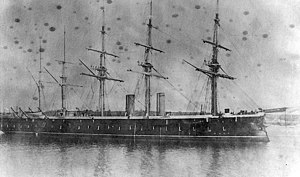HMS Agincourt (1865)

Agincourt at anchor
|
|
| History | |
|---|---|
|
|
|
| Name: | HMS Agincourt |
| Namesake: | Battle of Agincourt |
| Ordered: | 2 September 1861 |
| Builder: | Laird, Son & Co., Birkenhead |
| Cost: | £483,003 |
| Laid down: | 30 October 1861 |
| Launched: | 27 March 1865 |
| Completed: | 19 December 1868 |
| Commissioned: | June 1868 |
| Decommissioned: | 1889 |
| Out of service: | Hulked, 1909 |
| Renamed: |
|
| Reclassified: | Training ship, 1893 |
| Refit: | 1875–77 |
| Fate: | Broken up, 21 October 1960 |
| General characteristics (as completed) | |
| Class and type: | Minotaur-class armoured frigate |
| Displacement: | 10,627 long tons (10,798 t) |
| Length: |
|
| Beam: | 59 ft 6 in (18.1 m) |
| Draught: | 26 ft 10 in (8.2 m) |
| Installed power: |
|
| Propulsion: | |
| Sail plan: | 5-masted |
| Speed: | 14 knots (26 km/h; 16 mph) |
| Range: | 1,500 nmi (2,800 km; 1,700 mi) at 7.5 kn (13.9 km/h; 8.6 mph) |
| Complement: | 800 actual |
| Armament: |
|
| Armour: | |
HMS Agincourt was a Minotaur-class armoured frigate built for the Royal Navy during the 1860s. She spent most of her career as the flagship of the Channel Squadron's second-in-command. During the Russo-Turkish War of 1877–78, she was one of the ironclads sent to Constantinople to forestall a Russian occupation of the Ottoman capital. Agincourt participated in Queen Victoria's Golden Jubilee Fleet Review in 1887. The ship was placed in reserve two years later and served as a training ship from 1893 to 1909. That year she was converted into a coal hulk and renamed as C.109. Agincourt served at Sheerness until sold for scrap in 1960.
The three Minotaur-class armoured frigates were essentially enlarged versions of the ironclad HMS Achilles with heavier armament, armour, and more powerful engines. They retained the broadside ironclad layout of their predecessor, but their sides were fully armoured to protect the 50 guns they were designed to carry. Their plough-shaped ram was also more prominent than that of Achilles.
The ships were 400 feet (121.9 m) long between perpendiculars and 407 feet (124.1 m) long overall. They had a beam of 58 feet 6 inches (17.8 m) and a draft of 26 feet 10 inches (8.2 m). The Minotaur-class ships displaced 10,627 long tons (10,798 t). Their hull was subdivided by 15 watertight transverse bulkheads and had a double bottom underneath the engine and boiler rooms.
...
Wikipedia
